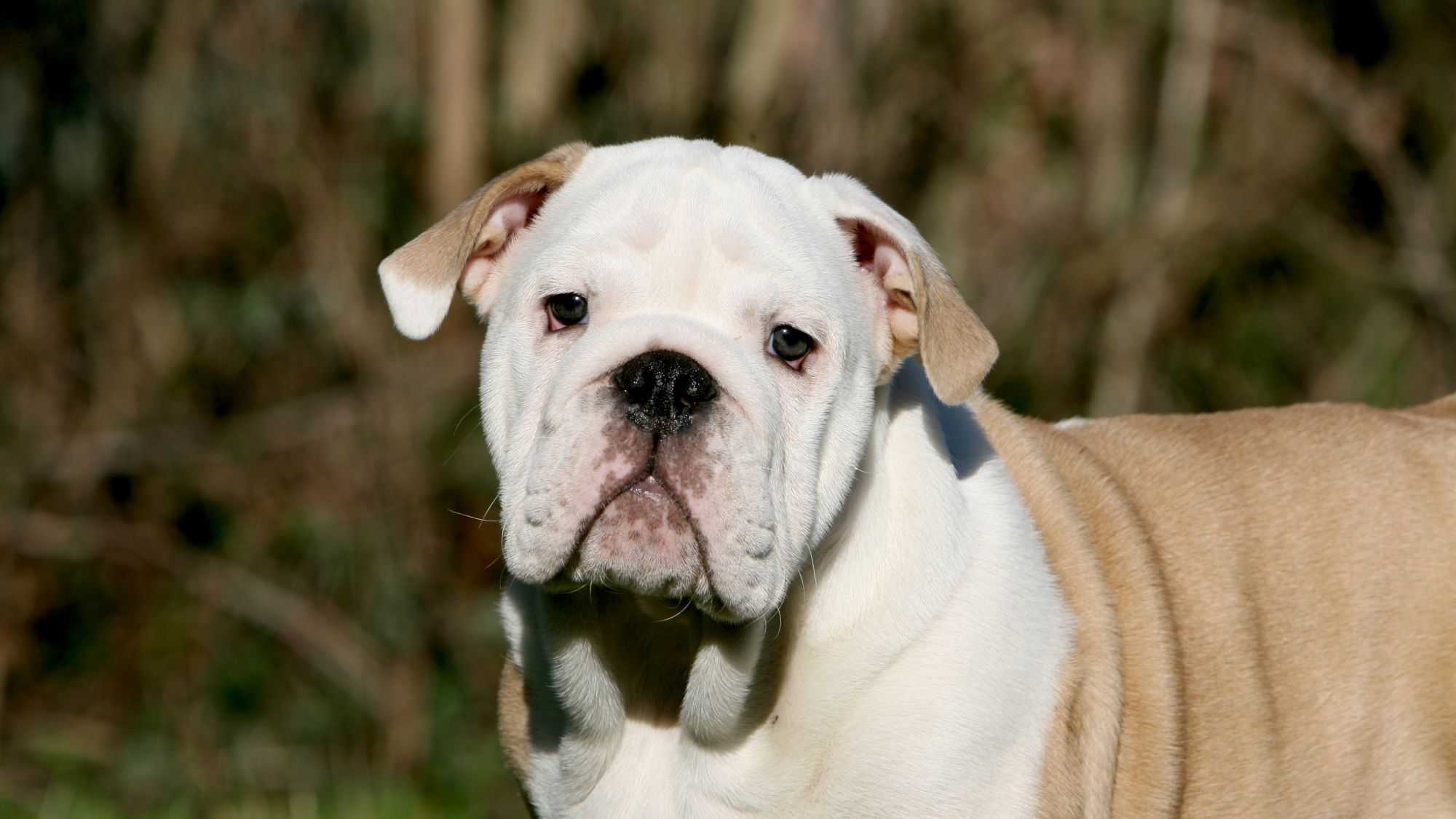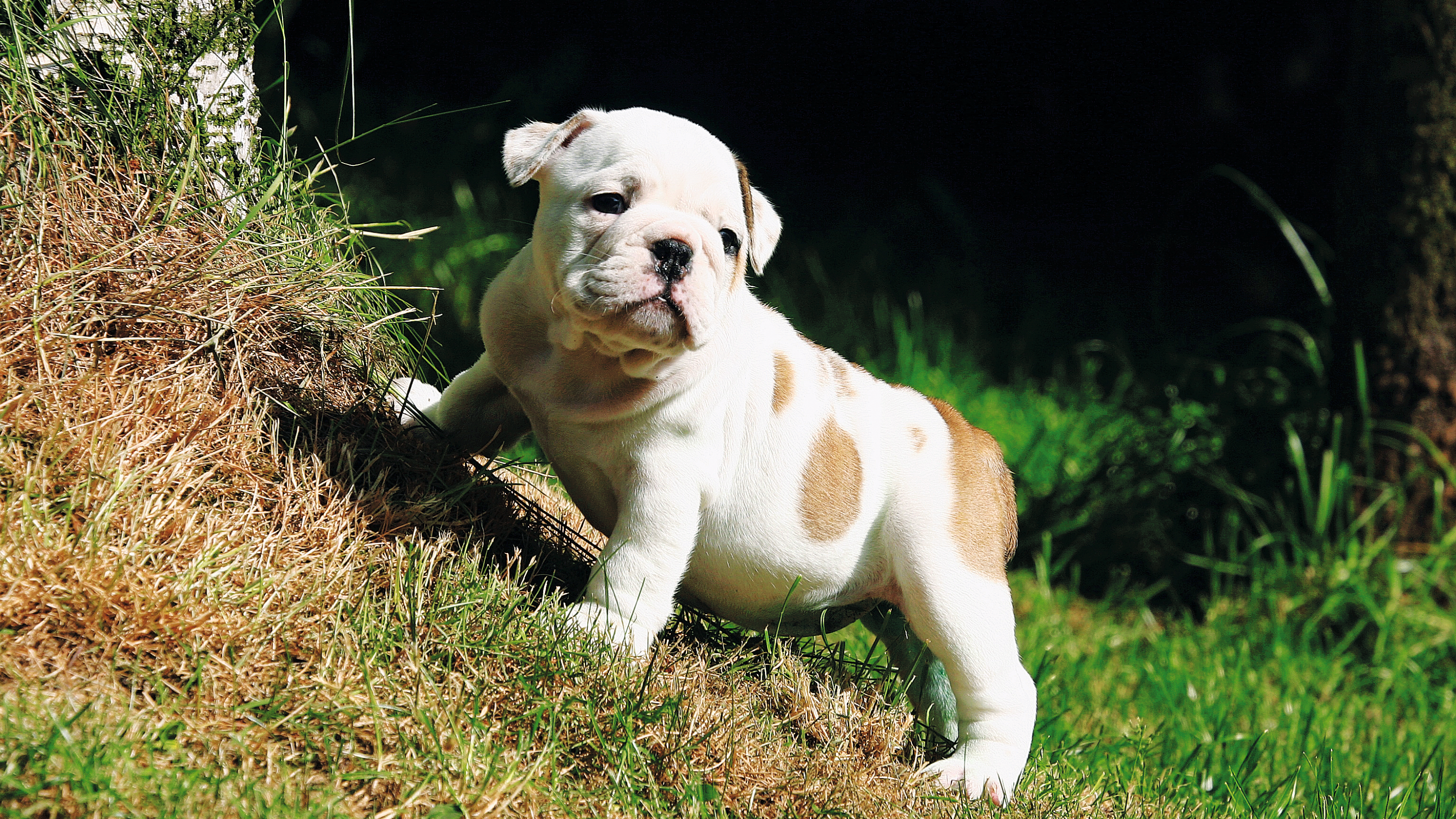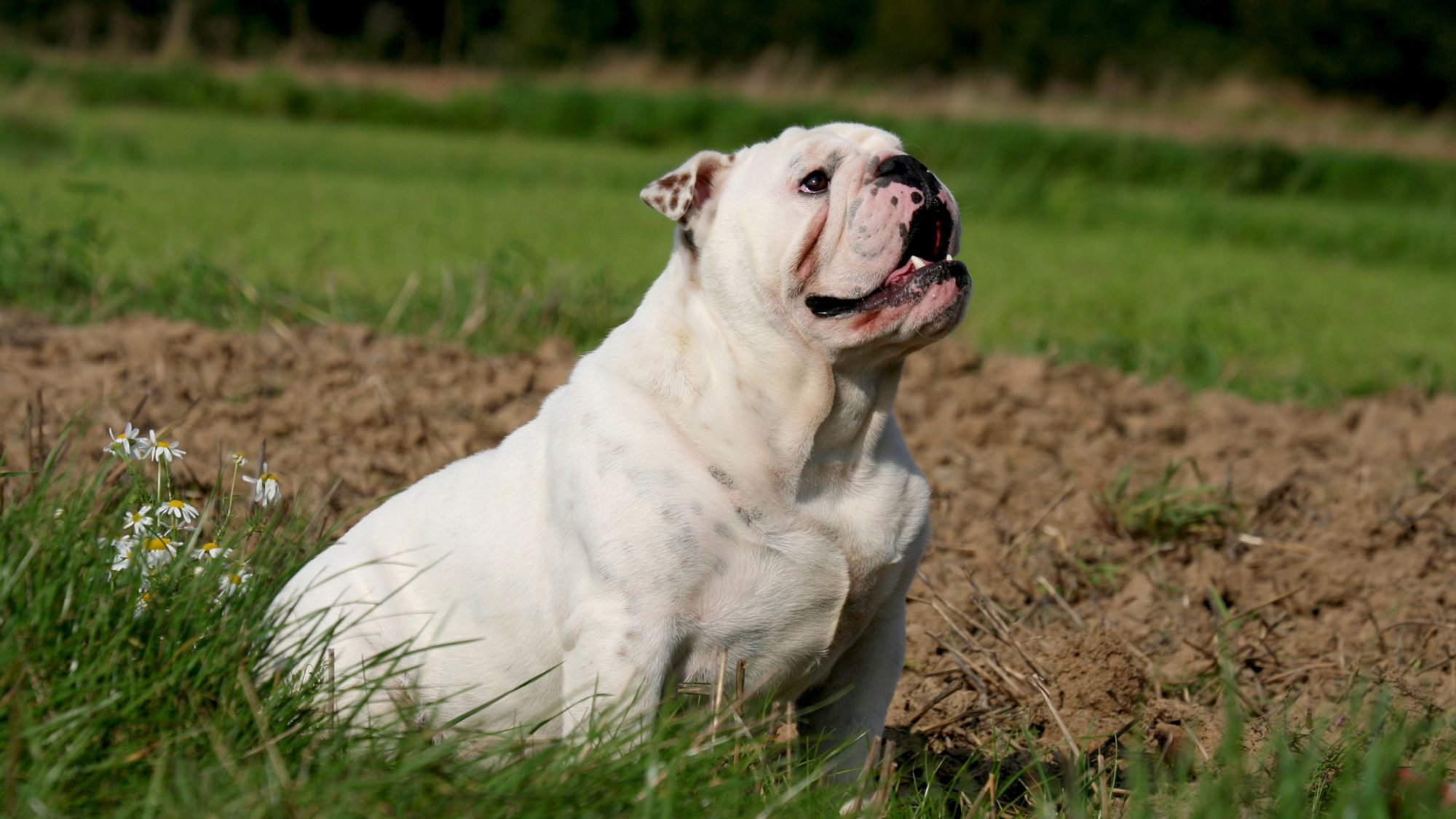Let's talk Bulldogs
Official name: Bulldog
Other names: English Bulldog, Old English Bulldog, British Bulldog
Origins: Britain
Drooling tendencies
5 out of 5Grooming needs
3 out of 5Shedding Level
3 out of 5Barking tendencies
4 out of 5Energy level
1 out of 5Compatibility with other pets
5 out of 5Warm weather?
1 out of 5Cold weather?
1 out of 5Suited to apartment living
4 out of 5Can stay alone
1 out of 5Family pet
4 out of 5
| Male | Female |
|---|---|
| Height | Height |
| 36 - 38 cm | 66 - 69 cm |
| Weight | Weight |
| 25 - 30 kg | 23 - 25 kg |
| Life Stage | |
|---|---|
| Puppy | Adult |
| 2 to 12 months | 1 to 7 years |
| Mature | Senior |
| 7 to 10 years | From 10 years |
| Baby | |
| Birth to 2 months | |
Drooling tendencies
5 out of 5Grooming needs
3 out of 5Shedding Level
3 out of 5Barking tendencies
4 out of 5Energy level
1 out of 5Compatibility with other pets
5 out of 5Warm weather?
1 out of 5Cold weather?
1 out of 5Suited to apartment living
4 out of 5Can stay alone
1 out of 5Family pet
4 out of 5
| Male | Female |
|---|---|
| Height | Height |
| 36 - 38 cm | 66 - 69 cm |
| Weight | Weight |
| 25 - 30 kg | 23 - 25 kg |
| Life Stage | |
|---|---|
| Puppy | Adult |
| 2 to 12 months | 1 to 7 years |
| Mature | Senior |
| 7 to 10 years | From 10 years |
| Baby | |
| Birth to 2 months | |

Get to know the Bulldog
All you need to know about the breed
Noble, docile and a best friend for life, the Bulldog has too many winning attributes to mention. They’re a fantastic family dog with intense loyalty, and are easily pleased with the simplest gesture – and like to please in return. Contrary to what some may think, the Bulldog isn’t the least bit lazy; their heftier build comes from decades of breeding and an original use as a sporting dog. And body confidence is in, haven’t you heard?
Their coat too is a perennial favourite. It’s smooth and short-haired, and comes in the classic beige and white with patches of either white or black, with the occasional brindle thrown in for fun. And drumroll, please… the Bulldog sheds very little.
Funny, Bulldogs look so tough but they are really a very sweet companion dog. One thing they will be grumpy about: scolding. So much so that they might ignore you for a bit if they feel it’s unjustified.
The Bulldog temperament is a courageous one; sometimes a little too much as they have a tendency to dominate other dogs. Not to worry: It just comes from being competitive. Bulldogs are super social with everyone in their midst, content with a few short walks each day. An exercise note: The Bulldog body is not good for longer sojourns or swimming. Their stocky build will not maintain buoyancy and isn’t built for long distances.
The biggest health concern for the Bulldog breed surrounds correct breathing due to the flat construction of their face and nostrils. Known as a brachycephalic breed, their short muzzles and noses and undersized breathing passages mean too hot or cold temperatures should be avoided. Cardiac problems, like arrhythmia or irregular heartbeats, can happen. Make routine veterinarian visits to keep your Bulldog in check, and remember to acquire your Bulldog from a responsible breeder.
Two facts about Bulldogs
1. A charming face that requires care
Your Bulldog's chops, or the folds of skin around their face, are extremely charming but need to be wiped often to make sure moisture and even food aren’t trapped inside. Use a clean, dry cloth to clean as often as possible.
2. When size might matter
Bullies are a hefty lot, a factor to consider if picking them up at home or loading them in and out of a car. Their dense body could be too much for one person. Pay close attention to their daily feeding to avoid undue weight gain.
History of the breed
The Bulldog breed can trace their legacy to 13th Century England and to the now-illegal sport of bullbaiting (thus the 'Bull' in their name), when the breed's predecessors – more stout dogs with larger jaws – were used to wrestle a bull to the ground. Thankfully, England banned the sport in 1835.
Due to their long relationship with British culture, the breed is now almost considered a national icon. In the United States, the breed became cherished as well, and named the mascot of some notable institutions as a result of their seemingly tough demeanour: Yale University made the Bulldog a mascot for all sports teams, affectionately dubbing him 'Handsome Dan', and the United States Marine Corps adopted the breed as their mascot after World War I. Breeders have continued to evolve the Bulldog temperament into the dog we know today, a true companion with an affable manner.
The Bulldog Club of America was established in 1890, and the breed has ranked in the American Kennel Club’s top five most popular breeds over the past seven years.
From head to tail
Physical characteristics of Bulldogs
1.Ears
2.Head
3.Body
4.Fur
5.Tail

Things to look out for
From specific breed traits to a general health overview, here are some interesting facts about your Bulldog
That flat face can be cause for concern
The Bulldogs’ most attractive feature might be their most hazardous: They are prone to respiratory problems due to their facial construction, which is called brachycephalic syndrome; one that’s characterized by a flattened snout and nostrils. Breathing difficulties – especially in hot or too-cold weather – can be common, or when their exercise session is too strenuous. Anaesthesia during surgery can also present problems with their flattened faces. Bulldogs do well in a space with proper ventilation and air conditioning where necessary.
Bulldogs do like to run. Just not far.
Despite their burly body, the Bulldog is one breed that enjoys agility training and has fun doing it. Don’t think that competition is reserved for the long-limbed canines of the world: The Bulldog’s competitive spirit means they’re always up for a good round of anything that tests their skill. The breed can run quickly, just not for long distances. Exercise is vital for any dog, and especially important for the Bulldog breed, one whose stocky body can top out at 50 pounds but still needs to stay fit and trim.
A breed with a tender heart
The Bulldog breed can have a predisposition to arrhythmia, also known as an irregular heartbeat. Although the condition is rare, it can arise and could possibly result in fainting when not picked up on. Bulldogs are also predisposed to tetralogy of Fallot, a congenital (meaning present at birth) cardiac malformation. Making regular visits to the veterinarian to conduct a proper diagnosis of your Bulldog is important for starters, and the right treatment will help either condition, should they occur.

Caring for your Bulldog
Grooming, training, and exercise tips
Moderate exercise is best for this breed. Make no mistake, they like to run and are very energetic, but not on a 5K. The breed cannot handle long distances as a result of their flattened faces and shortened snouts, which can make breathing difficult if they are put to the test too much. Quick spurts of play will be enough to tire them out. Avoid exercising in weather that’s too hot or too cold as either can be potentially dangerous. And, for some reason, Bulldogs love skateboarding, and are really good at it!
Bulldog owners are in luck: The breed’s short hair commands no more than a 10-minute brushing with a soft brush a few times a week. Bulldogs are known for those fetching wrinkles around their face and upper body – especially around the tail – however moisture can become trapped there, or even food in the facial area. Clean within the folds with a damp cloth followed by a clean, dry one to absorb moisture. Avoid the eye area, please! Bulldogs are prone to pododermatitis, inflammation of the skin and the paw. Make sure the feet are also kept clean and dry.
Obedient but reserved, the Bulldog enjoys human companionship but needs a gentle approach when it comes to discipline. They are an intelligent breed but can be vulnerable at times, especially when reprimanded too strongly. Satisfy their attention-seeking streak with affirmation and positive reinforcement.
Moderate exercise is best for this breed. Make no mistake, they like to run and are very energetic, but not on a 5K. The breed cannot handle long distances as a result of their flattened faces and shortened snouts, which can make breathing difficult if they are put to the test too much. Quick spurts of play will be enough to tire them out. Avoid exercising in weather that’s too hot or too cold as either can be potentially dangerous. And, for some reason, Bulldogs love skateboarding, and are really good at it!
Bulldog owners are in luck: The breed’s short hair commands no more than a 10-minute brushing with a soft brush a few times a week. Bulldogs are known for those fetching wrinkles around their face and upper body – especially around the tail – however moisture can become trapped there, or even food in the facial area. Clean within the folds with a damp cloth followed by a clean, dry one to absorb moisture. Avoid the eye area, please! Bulldogs are prone to pododermatitis, inflammation of the skin and the paw. Make sure the feet are also kept clean and dry.
Obedient but reserved, the Bulldog enjoys human companionship but needs a gentle approach when it comes to discipline. They are an intelligent breed but can be vulnerable at times, especially when reprimanded too strongly. Satisfy their attention-seeking streak with affirmation and positive reinforcement.
7/7
All about Bulldogs
Although they’ve got a tough look about them, it’s merely that: The Bulldog has a friendly demeanour and doesn’t tend to be threatening. Their use in the aggressive sport of bull-baiting was outlawed over 100 years ago, thankfully. The breed is now an endearing companion.
This incredibly easy-going breed is treasured by families and singles alike, valued for their affable manner and upbeat personality. The Bulldog temperament is a great one, making for a fabulous companion dog as they are calm and affectionate. The one concern for owners are any health problems that could arise from their more flattened snouts, which can potentially cause breathing problems. We recommend always acquiring your dog from a responsible breeder.
Tailored nutrition for your Bulldog
Read more on this topic
Sources
- Veterinary Centres of America https://vcahospitals.com/
- Royal Canin Dog Encyclopaedia. Ed 2010 and 2020
- Banfield Pet Hospital https://www.banfield.com/
- Royal Canin BHN Product Book
- American Kennel Club https://www.akc.org/
Like & share this page